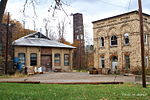Mount Savage Iron Works
Buildings and structures in Allegany County, MarylandDefunct manufacturing companies based in MarylandHistory of rail transportation in the United StatesIndustrial buildings and structures in MarylandIndustrial history of Maryland ... and 2 more
Ironworks and steel mills in MarylandMining in Maryland
The Mount Savage Iron Works operated from 1837 to 1868 in Mount Savage, Maryland. The ironworks were the largest in the United States in the late 1840s, and the first in the nation to produce heavy rails for construction of railroads. The works were established in an area adjacent to mines for coal, iron ore and fire clay. Facilities included blast furnaces, puddling furnaces, a rolling mill, iron refineries, coke production and brick production.
Excerpt from the Wikipedia article Mount Savage Iron Works (License: CC BY-SA 3.0, Authors).Mount Savage Iron Works
New School Road Northwest,
Geographical coordinates (GPS) Address Nearby Places Show on map
Geographical coordinates (GPS)
| Latitude | Longitude |
|---|---|
| N 39.698333333333 ° | E -78.883611111111 ° |
Address
New School Road Northwest 12700
21545
Maryland, United States
Open on Google Maps







